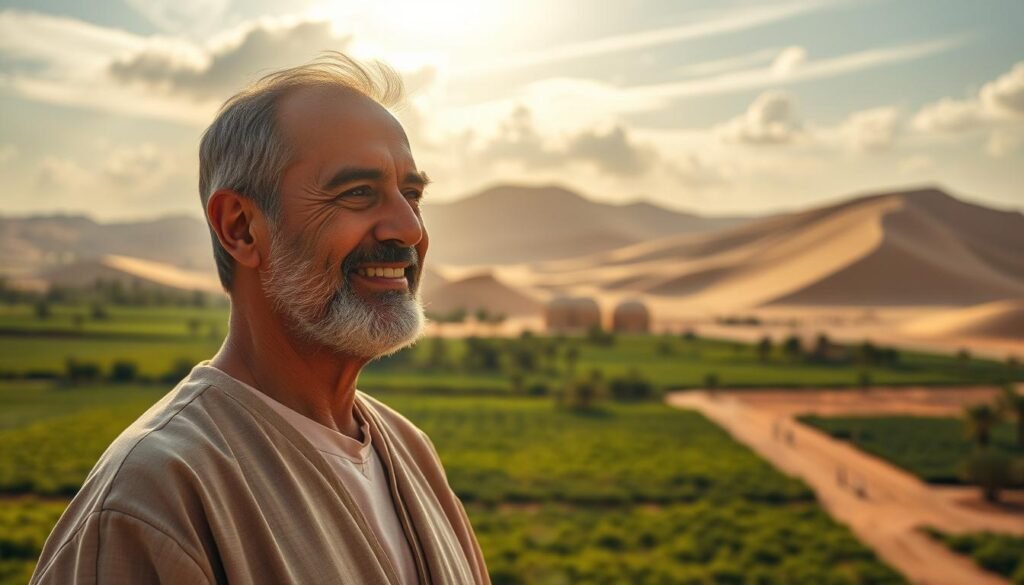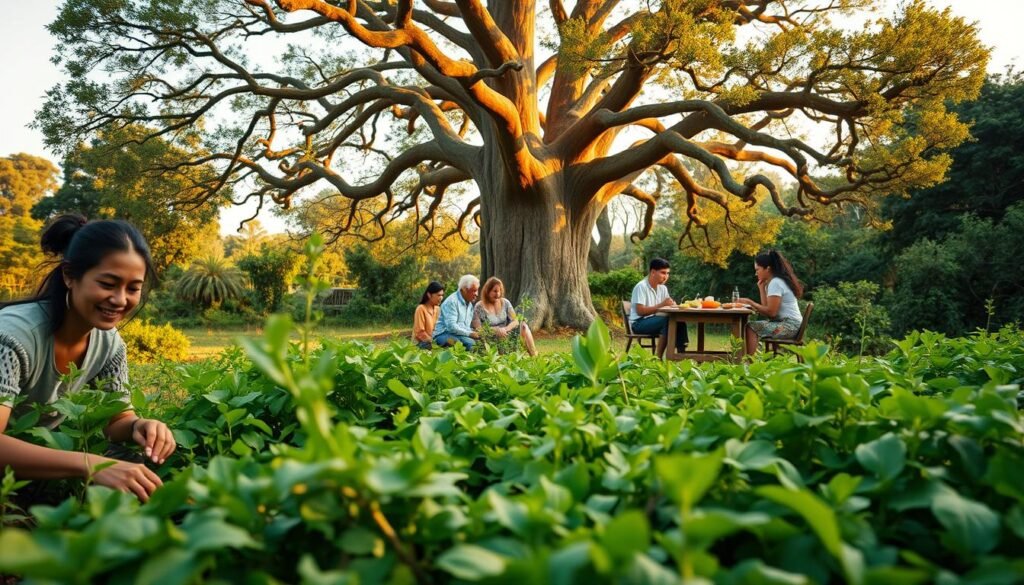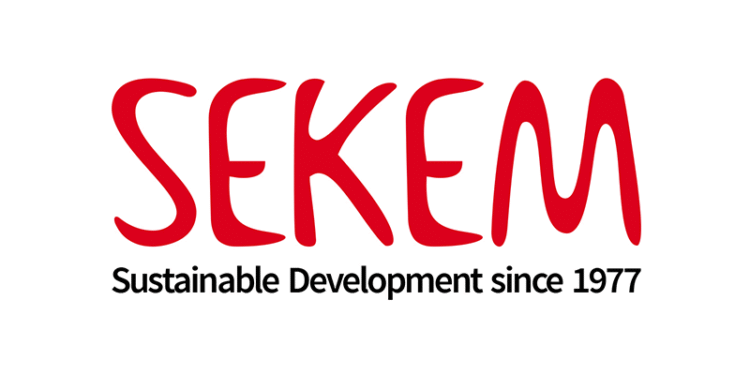Did you know a single desert farm launched in 1977 grew into a network that linked more than 2,000 farmers and global partners within three decades? That scale shows how local action can reshape land, markets, and lives.
SEKEM began when Dr. Ibrahim Abouleish turned arid soil into biodynamic farms and an integrated ecosystem of education, health, and commerce. The initiative connected organic food, herbal medicines, textiles, and other products to mission-led business models that served society.
The project combined schools, a medical center, research, and vocational training to build a resilient community. Its transparent, fair business approach helped stabilize supply chains and scale impact from Egypt to partners in India, Senegal, and beyond.
Key Takeaways
- The case shows how agronomy, education, and business can link for measurable social and ecological outcomes.
- Products like organic food and herbal remedies anchored a values-based market model.
- Community services—schools and healthcare—reinforced long-term local resilience.
- Principles such as true-cost thinking guided decisions toward regeneration.
- Recognition and partnerships validated a replicable approach for sustainable development.
Inside the SEKEM Case Study: Transforming Desert into a Thriving Sustainable Community
A barren seventy-hectare plot on the Nile’s edge became a living experiment in healing soil and creating dignified work for local people.
Beginning in 1977, planners planted roughly 120,000 seedlings as tree belts and shelterbelts. These belts, plus protective landscaping, cut wind and stopped erosion. Compost and water management rebuilt soil structure and boosted fertility.
Small-scale dairy, crops, and medicinal herb plots grew into model farms that produced milk, food, and export-grade ingredients within a few years. Traditional adobe buildings housed services while early clinics and cultural programs met basic needs.
Social inclusion mattered: nearby Bedouin families found jobs and support, and a kindergarten started in 1988 became a Waldorf-inspired K–12 school. The Chamomile Children project supplied education, meals, and health care for working children.
Integrated planning for trees, compost, and water created resilient microclimates. These early ecological choices turned harsh desert into productive land and set the stage for scaling sustainable practices across more farms and regions—an enduring marker of long-term success.
Origins and Vision: Dr. Ibrahim Abouleish’s Desert Initiative and Early Breakthroughs
In the late 1970s, one researcher swapped lab coats for field boots to tackle soil and social decline in Egypt.

From Austria to Egypt
Dr. Ibrahim earned a PhD in Pharmacology and led pharmaceutical research in Austria until 1977. A 1975 visit exposed him to pressing social and environmental needs, prompting a dramatic career shift. He returned with scientific rigor and a values-led vision to start a desert development experiment.
Regenerating the land
Biodynamic farming became the core approach. Teams built tree belts, applied compost, and used biodynamic preparations to rebuild soil life. These farming methods cut erosion, raised fertility, and made cultivation viable in arid conditions.
Community first
Early priorities included a medical center for local health and cultural programs to strengthen social life. A Waldorf-inspired school and a kindergarten followed, anchoring education and community resilience.
Early enterprise and scale
Commercial ventures financed growth. Initial products like ammoidin extracts, herbal teas, and fresh organic produce generated revenue. In pivotal years, trials with organic cotton proved viable and led to the creation of NatureTex to process sustainable textiles.
These choices blended scientific methods with local action, seeded replicable development models, and built credibility with partners and stakeholders.
SEKEM’s Integrated Model: Organic Agriculture, Social Cultural Development, and Research
Local farms, value-added processing, and education combined to power lasting social change.
The organic economy in practice links food, cotton, and medicinal products to mission-led companies that reinvest profits in community development. Processing units for teas, phyto-pharmaceuticals, and textiles turn harvests into market-ready goods. This value chain keeps smallholder farmers connected to steady buyers and fair prices.
Organic economy in practice: Food, cotton, and medicinal products powering development
Farms supply raw material to brands like NatureTex and ATOS Pharma. Selling finished goods funds schools, clinics, and technical programs. That circular model sustains growth without outside subsidies.
Education and vocational training: Schools, Chamomile Children, and skilled workforce development
A ladder of education moves children from kindergarten to a Waldorf-inspired school and into vocational training. The Chamomile Children program blends work, care, and learning so youth gain practical skills and social support.
Heliopolis University for Sustainable Development: Research, policy influence, and true cost accounting
Heliopolis University drives applied research and policy work. The university sustainable agenda produced a 2016 True Cost Accounting study that showed organic systems are often cheaper when external costs are counted. Research informs national practices like sustainable pest management.
Standards and scale: EBDA farmer training and COAE certification advancing biodynamic farming
The Egyptian Biodynamic Association trains farmers in biodynamic farming, while COAE certifies organic farms. Together they scale standards, improve yields, and help enterprises meet export requirements.
SEKEM
A people-centered approach linked farmers, workers, and land stewardship into a resilient local economy.

People and land: Farmers, employees, and the cooperative model supporting equity
These meetings tied fair payment to responsible land care and helped suppliers plan seasons and sales.
The Cooperative of Employees channels benefits into training, health care, and career development.
Staff dedicate 10% of work time to professional and personal growth, which boosts quality and morale.
Business with purpose: Transparency, fair pricing, and stable supply chains
By aligning incentives across producers, processors, and buyers, the model stabilizes supply chains for key products.
A holding company coordinates finances and social aims, while a development foundation delivers education and cultural services.
About 1,800 people were employed, with roughly 55% of sales sold domestically — strengthening the local economy.
Equity mechanisms—cooperative decision-making and access to services—support inclusive development and steady work.
Proven Impact: Policy Change, Productivity Gains, and Global Reach
Field-tested methods in cotton production proved that higher yields and fewer chemicals can go hand in hand. Pilot cotton plots recorded nearly 30% higher yields than conventional fields while cutting synthetic pesticide use dramatically.
Egyptian cotton revolution
Multi-year research and on-farm trials validated sustainable pest control. The Ministry of Agriculture ran tests over three years and then phased the methods across the national cotton area—about 4,000 km²—reducing aerial spraying and synthetic inputs by over 90%.
Measurable growth and market reach
By 2005 the network included 2,000+ farmers and many farms supplying processors and companies in the group. Revenues rose from 37 million EGP in 2000 to 100 million EGP in 2003, with products sold domestically and exported to Europe and North America.
Awards and recognition
Research outputs shaped policy and enterprise choices, creating a tight feedback loop between labs, fields, and companies. This work earned global credibility—highlighted by the 2003 Right Livelihood Award and Schwab Social Entrepreneur honors—helping scale development of agriculture value chains and everyday training that kept standards consistent across hectares and years.
Conclusion
A long-term experiment in the desert shows how integrated enterprises can restore land and livelihoods.
The initiative links ecological regeneration of soil and land with mission-driven business and social services. This model demonstrates practical sustainable development that produces food, products, and stable work across hundreds of hectares.
Education and vocational training prepare people to steward farming systems and adopt resilient methods. Heliopolis University and applied research translate findings into policy and farm-level practices.
Dr. Ibrahim Abouleish’s legacy of biodynamic farming, EBDA training, and organic certification created pathways to scale. Community institutions—schools, clinics, and cooperatives—tie social progress to soil health and long-term development.
Adapt these elements—research, certification, training, and cooperative business—to local contexts to drive health, livelihoods, and lasting sustainable development worldwide.
FAQ
What is the core mission of the SEKEM initiative?
The initiative aims to transform desert land into a productive, biodynamic landscape while promoting cultural development, education, and a fair organic economy. It combines organic agriculture, vocational training, and community services to improve health, livelihoods, and local ecosystems.
Who founded the project and why?
Dr. Ibrahim Abouleish founded the project in 1977 after experiences in Austria and Egypt. He sought to restore degraded desert soils, create sustainable livelihoods, and build integrated social and cultural institutions that support long-term development.
What farming methods are used to regenerate the desert?
The approach centers on biodynamic farming, compost production, tree belts, and organic soil preparations. These methods restore fertility, increase water retention, and reduce reliance on chemical inputs while improving yields for crops like food, cotton, and medicinal plants.
How does the project support education and vocational training?
The program includes schools inspired by Waldorf principles, vocational training centers, and outreach for farmers. Heliopolis University for Sustainable Development provides higher education and research focused on sustainable agriculture, policy, and true cost accounting.
How are farmers and workers organized within the model?
Farmers and employees participate through cooperative structures and EBDA-style training programs. The model emphasizes equitable partnerships, fair pricing, and skills development to ensure community ownership and sustainable livelihoods.
What role do companies and products play in the model?
Social enterprises produce organic food, herbs, textiles, and other products to finance community services. Transparency, stable supply chains, and fair-trade practices help scale production and provide market access domestically and for export.
How does the project measure environmental and economic impact?
Impact is tracked through productivity gains, pesticide reductions, soil health indicators, and market growth. Research from Heliopolis University and partnerships with certification bodies like COAE support monitoring and continuous improvement.
Has the initiative influenced national or regional policy?
Yes. Evidence from reduced agrochemical use and higher yields has informed policy discussions on sustainable farming, while research and advocacy from the university and partners have shaped sector standards and farmer training programs.
What kinds of products are produced and marketed?
The model produces organic food, medicinal herbs, and cotton-based textiles, among other goods. These products support local nutrition, health initiatives, and export revenue that fund education, health care, and community projects.
How has the project been recognized internationally?
The initiative has received awards and global recognition for social entrepreneurship and sustainable development, highlighting its scalable model for converting marginal land into thriving ecosystems and economies.
How can other communities replicate this model?
Replication requires integrated planning: adopt biodynamic and organic methods, invest in education and vocational training, build fair enterprises, and measure ecological and social outcomes. Partnering with universities and certification bodies helps ensure technical rigor and market credibility.
Where can I learn more or access research and training resources?
Research publications, training curricula, and case studies are available through Heliopolis University for Sustainable Development and affiliated training centers. These resources detail farming methods, cooperative structures, and strategies for scaling impact.





